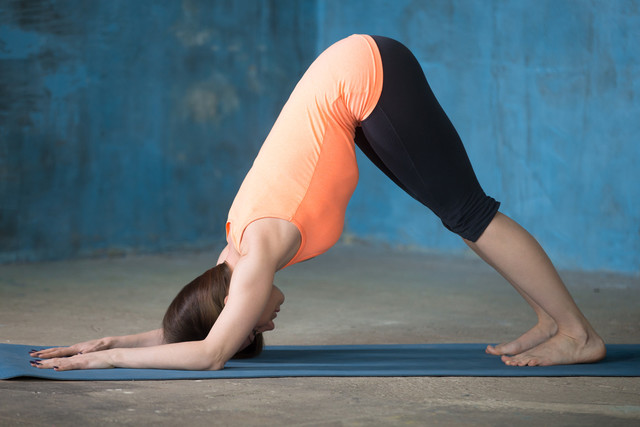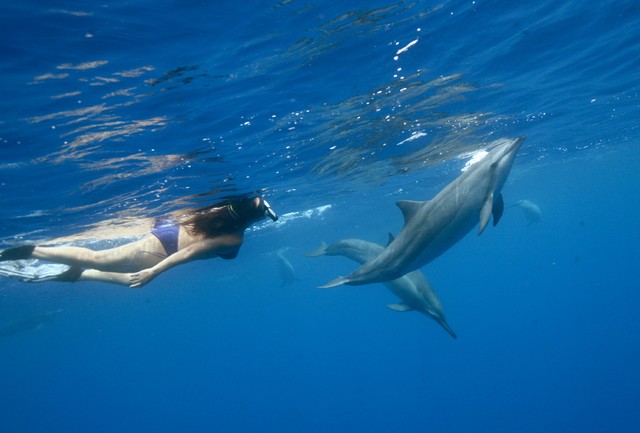There may be no better yoga pose to represent “peace on earth and goodwill toward men” than Makarasana, the sea creature pose. In yoga tradition, the makara is a fabulous water beast, part crocodile with an elephant’s head, sometimes part
There may be no better yoga pose to represent “peace on earth and goodwill toward men” than Makarasana, the sea creature pose. In yoga tradition, the makara is a fabulous water beast, part crocodile with an elephant’s head, sometimes part stag or peacock, who serves as the vehicle of the river goddess Ganga.
Modern variants, the forearm plank and the dolphin pose, are more vigorous but they all encourage diaphragmatic breathing, relax the nervous system, and harness the primal powers in our watery depths to give us a true heart and insight.
The Sanskrit Epic
While each yoga pose is fresh in the moment, here and now, reflecting the elements, plant forms, animals, sages and geometrical shapes, they are also embodiments of ancient stories. Just as a picture tells a thousand words, the story behind the form turns the physical yoga experience into a journey of the soul.
The oldest Sanskrit poem, the Ramayana, tells of Sita who is kidnapped by the demon Ravana and imprisoned on the island of Sri Lanka. Hanuman, Rama’s superhero monkey friend, helps rescue Sita, defeat the demon, and save Rama’s brother’s life by flying to the Himalayas to obtain a sacred healing herb.
On his way back, he pauses at a sparkling lake to drink, cool himself, and swim. A crocodile suddenly catches his foot, pulls him under, and swallows him, along with a mountain!
But Hanuman is no ordinary superpower. He changes size and shape at will. Instant, he expands himself, bursting the crocodile’s body to free himself. As the monkey god rises up over the water, he sees a delicate, lovely nymph hovering just above the crocodile’s corpse.
“Son of the Wind!” she calls to Hanuman. “I am so grateful! Ravana cursed me to be in crocodile form until I should meet the servant of Rama. When I caught hold of your feet, the curse was lifted. Now I am free!”
It had been a ruse set by the demon. The liberated nymph flies home to heaven, Hanuman restores the lake’s purity, satisfies his thirst, and speeds away to bring healing to Rama’s brother.
Steps for Makarasana
Three phases of this pose, the crocodile, plank, and dolphin, elevate us in stages. Breathe deeply through 3 – 5 sun salutes to warm up. Your body rides the breath like a swimmer flowing in ocean waves. Avoid these poses if you are pregnant.
Crocodile, for rest and rejuvenation: Stretch out your belly and chest on the Earth, like a crocodile luxuriating in the soft mud, with arms reaching forward. Both legs stretch back. Fold your arms, place your hands on opposite elbows, and deepen arm bones into shoulder sockets. Melt the chest, relax the abdomen, and open the backside of the lungs, heart, and sides of the waist. Gentle the skin around the neck, jaws, and face.
Forearm Plank, for stability and strength: Bring your elbows directly under the shoulders and elongate your forearms forward. Firm upper and lower arms as you press your palms, fingers, and inner wrists into the Earth, creating a line of energy that keeps you steady. This is your foundation.
Curl your toes under, engage your center, and lift the hips so the straight body is parallel to the Earth. Press the forearms down, lift the belly and chest, soften the roof of your mouth, and feel the root of the tongue. Inhale and exhale from the nostrils all the way to the tailbone and toes.
Dolphin Pose, for grace and power: Keep your shoulders over your elbows and exhale, lifting your hips high to the sky. Walk feet toward the arms to make a pyramid shape. Ears in line with your upper arms, head reaching down, your neck releases and lengthens. Press your metatarsals down to engage and lift the fronts of the legs to open the hamstrings. Resist moving the arms toward the fingertips; lift your hips away from the shoulders to lengthen the torso. Keeping abdominals engaged, gaze at the navel and hold for several deep breaths. Exhale to your knees. Rest in Balasana, child’s pose.
Practicing Makarasana 10 minutes a day to bring clarity and equilibrium. Makarasana poses build awareness, assist digestion, relieve low back pain, and can prevent menstrual cramping.
Reflection
B. K. S. Iyengar once said that the study of asana is not about mastering posture, but about using posture to understand and transform yourself. When we lift our bodies from the muddy depths of crocodile to the fleet beauty of the dolphin, we raise our spirits.
When we’re with dolphin and whales in the wild, with their smooth bodies, iridescent colors and intelligent grins, we sense what no description of marine life can ever capture: the intelligence, beauty, and joy of these creatures.
We learn from sea creatures how to live in the flow, overcome limitations, cultivate change, and emerge from the corpse of old reptilian armor like the celestial nymph who arises from the monster’s body.
Like Hanuman, we expand consciousness to break out of old patterns. Like the dolphin, we can feel every movement as part of a larger harmony that brings peace to Earth, to the sea, and good will toward all.
Marya Mann, PhD., author, yoga teacher, wellness consultant, art activist and humanitarian. Contact her at marya.mann@gmail.com




